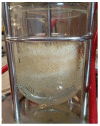Linum lewisii Adventitious and Hairy-Roots Cultures as Lignan Plant Factories
- PMID: 36009248
- PMCID: PMC9404846
- DOI: 10.3390/antiox11081526
Linum lewisii Adventitious and Hairy-Roots Cultures as Lignan Plant Factories
Abstract
Plants synthesize specific secondary metabolites for survival, reproduction, environmental resilience, and defense. Among them, lignans are a class of polyphenols with several bioactive properties: chemopreventive, anti-inflammatory, antiviral, and antioxidant. These compounds are often extracted from field-grown plants with very low yields. To overcome these constraints, in vitro tissue cultures provide a tool to optimize large-scale production. Moreover, the use of elicitation to increase secondary metabolite production is gaining importance. The aim of this work was to develop adventitious (ARL) and hairy roots (HRL) from Linum lewisi, a species able to synthesize arylnaphthalene lignans such as justicidin B. The ARL and HRL were obtained for the first time and characterized for their phenol content, antioxidant activity, and the production of justicidin B after treatments with several elicitors and precursor feeding. Through NMR spectroscopy, other four lignans were highlighted and identified in the roots extracts. A pilot-scale bioreactor was adopted to assess the suitability of the developed root cultures for future large-scale production. The ARL and HRL cultures showed a justicidin B production higher than other Linum species cultures described up to now (75.8 mg/L and 82.2 g/L), and the production more than doubled after elicitation with MeJA.
Keywords: antioxidant capacity; elicitation; flax; justicidin B; lignans; precursor feeding; tissue cultures.
Conflict of interest statement
The authors declare no conflict of interest.
Figures










Similar articles
-
Arylnaphthalene and aryltetralin-type lignans in hairy root cultures of Linum perenne, and the stereochemistry of 6-methoxypodophyllotoxin and one diastereoisomer by HPLC-MS and NMR spectroscopy.Phytochem Anal. 2015 Sep-Oct;26(5):310-9. doi: 10.1002/pca.2565. Epub 2015 May 15. Phytochem Anal. 2015. PMID: 25982186
-
New Insight into Justicidin B Pathway and Production in Linum austriacum.Int J Mol Sci. 2021 Mar 2;22(5):2507. doi: 10.3390/ijms22052507. Int J Mol Sci. 2021. PMID: 33801525 Free PMC article.
-
Production of justicidin B, a cytotoxic arylnaphthalene lignan from genetically transformed root cultures of Linum leonii.J Nat Prod. 2006 Jul;69(7):1014-7. doi: 10.1021/np060022k. J Nat Prod. 2006. PMID: 16872135
-
Justicidin B: A Promising Bioactive Lignan.Molecules. 2016 Jun 23;21(7):820. doi: 10.3390/molecules21070820. Molecules. 2016. PMID: 27347906 Free PMC article. Review.
-
Elicitation: A biotechnological tool for enhanced production of secondary metabolites in hairy root cultures.Eng Life Sci. 2019 Jul 25;19(12):880-895. doi: 10.1002/elsc.201900058. eCollection 2019 Dec. Eng Life Sci. 2019. PMID: 32624980 Free PMC article. Review.
Cited by
-
Stimulation of Lignan Production in Schisandra rubriflora In Vitro Cultures by Elicitation.Molecules. 2022 Oct 7;27(19):6681. doi: 10.3390/molecules27196681. Molecules. 2022. PMID: 36235218 Free PMC article.
References
-
- Wink M. Plant Breeding: Importance of Plant Secondary Metabolites for Protection against Pathogens and Herbivores. Theoret. Appl. Genet. 1988;75:225–233. doi: 10.1007/BF00303957. - DOI
-
- Landete J.M. Plant and Mammalian Lignans: A Review of Source, Intake, Metabolism, Intestinal Bacteria and Health. Food Res. Int. 2012;46:410–424. doi: 10.1016/j.foodres.2011.12.023. - DOI
-
- Ford J.D., Davin L.B., Lewis N.G. Plant Lignans and Health: Cancer Chemoprevention and Biotechnological Opportunities. In: Gross G.G., Hemingway R.W., Yoshida T., Branham S.J., editors. Plant Polyphenols 2: Chemistry, Biology, Pharmacology, Ecology. Basic Life Sciences; Springer; Boston, MA, USA: 1999. pp. 675–694. - PubMed
Grants and funding
LinkOut - more resources
Full Text Sources

